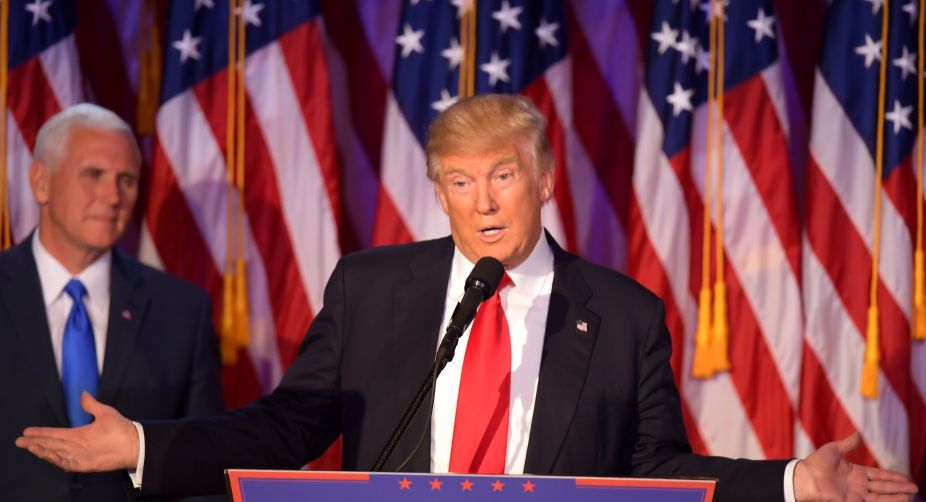The final doomsday countdown has begun for the Trans-Pacific Partnership (TPP). Donald Trump will take the oath to become the 45th President of the United States in one week, on 20 January.
In an announcement that sent shock waves across the world, the President-elect had said on 21 November 2016 that on his very first day in office, he would kill the agreement that 12 nations had negotiated for years. Without its major driving force, the US, as a member, the trade pact, said to be the biggest ever breakthrough in global trade liberalisation, simply cannot pull its weight.
Under the agreement’s rules, the TPP can only come into force if it is ratified by at least six members representing 85 per cent of the group’s combined GDP. By itself, the US accounts for nearly 60 per cent of the group’s GDP.
Trump, essentially a businessman and a hawkish “America first” advocate, had repeatedly slammed TPP for not giving the US any direct and profound economy-wide benefits and taking away jobs from American people.
However, January 20 is yet to come and it may be too soon to pronounce the TPP dead, because it remains uncertain if Trump meant he could do it or he would do it. If some trade experts or even politicians are still clinging to hopes that the landmark pact, combining 36 per cent of world GDP, can be brought back to the negotiation table, there is no need to call them delusional.
Stranger things have happened. Just look at how things unfolded during the 2016 US Election. At the outset, not many people gave Trump even an outside chance at being the US President. Now he is on the verge of being sworn in.
Trump may reconsider his own TPP decision because perspectives are different from the driver’s seat of the US economy. He has to consider not just foreseeable economic benefits but the merits and demerits of his country’s global trade leadership role in the years to come.
Anyway, here in Viet Nam, a TPP member long hyped as its largest beneficiary, the agreement is no longer an issue of major concern. The focus is on how trade liberalisation will move in the coming months and years, with or without the US, and what the new directions are for smaller TPP members, especially export-driven economies like Viet Nam.
For all the touted benefits, the TPP’s collapse is not likely to be devastating for its member nations, fortunately.
“Do not expect any dramatic economic consequences from TPP’s demise” said Stephen Olson, a scholar at the Hong Kong University of Science and Technology. “Trade is already open and flowing at robust levels amongst many TPP partners and that will continue.”
According to the Asian Development Bank, from 2000 onwards, nearly 100 new free trade agreements (FTAs) have been signed in the Asian region alone. Within the TPP group, the game leader – the US – has FTAs in place with 6 of its 11 members.
Viet Nam, a comparatively small economy, has signed 12 FTAs with powerful economic blocs like the EU, and with large economies like Japan and South Korea.
Prominent economist Võ Trí Thành, chairman of Vietnam’s Asia Pacific Economic Cooperation (APEC) 2017’s organising committee, said: “TPP’s demise is disappointing, but with or without TPP, the global trade liberalisation trend is irresistible.
“I think it is human nature to be eager to explore new things, learn new ways and get connected. In business, the production and trade capacity of each country is so huge and diverse it can’t satisfy its own demand without international trade connectivity.”
Thành said the benefits of free trade’s lower tariffs, better connectivity and larger markets encourage businesses to exploit gains from global specialisation and develop value chains.
“TPP’s dissolution may cause some fluctuations in the global market, but it definitely can’t reverse the free trade trend. Free trade will remain the mainstream (form of) economic cooperation in the world,” he said.
His observations seem to match what the 11 remaining TPP signatories have been doing over the last couple of months.
Following Trump’s statement, there have been clear signals that TPP members in Asia are shifting their attention to other trade opportunities. The Regional Cooperation Economic Partnership (RCEP), a proposed trade initiative including the 10 ASEAN members plus China, Japan, South Korea, India, Australia and New Zealand, has been most talked about recently.
Negotiations on RCEP started in 2012 and 16 rounds have been completed so far, covering trade in goods and services, competition policies and dispute settlement, among other things. Even though some economists have said RCEP does not match TPP in terms of the level of liberalisation, it is now an alternative choice for many TPP members. If adopted, RCEP would be the largest free trade bloc in the world, accounting for 40 per cent of global trade and 45 per cent of the world’s population with a combined GDP of US$22 trillion.
When one country is said to benefit most from a pact, it also stands to lose the most from its demise, and several experts have remarked on this fact. But a specter of gloom, with falling foreign investment and limited export markets, is uncalled for.
“With or without TPP, the Vietnamese economy will stay on a positive note because all the preparatory work and reforms in the lead up to TPP have been underway, leading to new, positive changes beneficial to the business community and national sustainable development,” Thành said.
Over the last three months, Vietnamese Prime Minister Nguyen Xuân Phúc has consistently sent out a firm message in response to people’s concerns about TPP: “With or without TPP, we will move on with our open-door policy and our ongoing reform process.”
Those who are familiar with Vietnamese politics know that the country’s independent open policy is not a newfound thing, but a consistent pursuit for the last 30 years.
Viet Nam has entered into trade agreements with 55 nations. It is currently home to 21,666 FDI projects worth $293 billion, with investors from more than 100 different countries. Its enthusiastic involvement in the TPP negotiation process over the last seven years and its readiness to verify the agreement signals its strong commitment to international integration and trade liberalisation.
But one additional fact can be highlighted here. Viet Nam is also one of the first TPP members that put the agreement’s ratification on hold, even before Trump’s video statement was released. This caution shows Viet Nam’s adaptability and flexibility to global fluctuations.
Over thousands of years, Viet Nam has faced unexpected situations galore, and it has always managed to land on its feet. The "secret" is traditional – adaptation. As a Vietnamese saying goes: “O bau thi tron, o ong thi dài” (Live in a gourd, you grow round. Live in a tube, you grow long).
(The writer is Deputy Editor-in-Chief,Viet Nam News. This is a series of columns on global affairs written by top editors from members of the Asia News Network and published in newspapers across the region)












